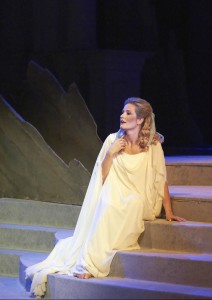
Richard Strauss’s Ariadne auf Naxos is an opera within an opera; or rather two operas, the first half, the preparations, opera in progress, the second Act, Ariadne in Naxos. Strauss in Capriccio explored the meaning of opera, whether opera is more about Words (librettist) or Music (the composer): both rivals for their patroness. Similarly Ariadne is commissioned by a rich Viennese patron for a palace soiree. He commissions an opera buffo by a young Viennese composer, and also an Italian Harlequinade. Like Capriccio, work in progress, but rather Noises Off in Ariadne. Relations between the companies break down when the Master announces the two pieces be performed simultaneously not consecutively.
The composer , affectingly sung by Sophie Koch, is outraged. For the composer, it is a question of artistic integrity. Music is lauded as the highest of the arts. Strauss, however, engages with artisic idealism confronted by (political) realities.The star of the harleqinade troupe Zerbinetta (Daniela Fally) has to persuade the composer that idealism can’t win against reality. So, in the compromise, the opera piece will have harleqinade intervals.
The closing of Act 1, the confrontation, and reconciliation between the opposites, is a highlight of the opera. Strauss’s scoring of the growing intimacy between the brittle composer melted by the warm exhuberant chanteuse reminds of Marshallin and Octavian bittersweet duets in Der Rosenkavalier. And in Ariadne the male composer is intriguingly played by a woman (in drag), thus eliciting a frisson of sexual ambivalence.
In stark contrast to a world of court intigue is the classical tranquility of the second Act on the island of Naxos. Ariadne (Camilla Nylund) is huddled, cocooned in white drapes, longing for death; and oblivious to the three nymphs veiled in white,trying to comfort her. And she ignores the appearance of the loudly bustling harliquinades. Now Zerbinetta , drawing on her worldly experience, consoles Ariadne woman to woman, and invokes the life principle of continual, endless change: metamorphosis. Fally’s bravura performanc was enthusiastically applauded . She projected the charm and lightness of operetta, with the chutzpah of (earthy) music hall entertainer.
Cut to the arrival of Bacchus (Ian Storey). A ship is sighted with Bacchus, the god of youth and perpetual regeneration (escaped from the enchantress Circe). Mistaken by Ariadne for the messenger of death, Ariadne welcomes him. Her morbid thoughts are transformed into the feelings of first love: she is renewed,’another’. The ensuing duet- prolonged and ecstatic- as they embark on Bacchus’s ship, is the highpoint of the opera.There are glimpses of (Wagner’s) Tristan und Isolde, but this is Richard Strauss at his finest, equal to the sublime closing duet in Rosenkavalier.
We see Zerbinetta observing the embarking ship behind white veiled curtain , a mortal glimpsing the transcendental; and framing the classical action back in the real world.
Although balconies (side of stage) are used with harlequinade players to reconnect with the outer opera, the second Act Ariadne appears a separate entity- different in tone , from opera buffo to spiritual stillness. But on subsequent viewing , Strauss’s conception seems even bolder. Punctuating a classical narrative with latter-day interruptions -clowns, music hall chanteuse- is subversive, ironic (pre-figuring our postmodern.)
Filippo Sanjust’s sets and costumes, used since 1976, still work well. The first Act Viennese palace with numerous candelabra and ornate fitings is well suited to Strauss’s 18th century (Maria Theresa) setting. Of the cast, Sophie Koch’s impassioned composer was justly well applauded. Nylund was at her best in the final duet. Ian Storey in his Vienna debut received a mixed reception. Conductor Jeffrey Tate, from the sparse string sections of the chamber ensemble like opening to the climactic opulence of the Ariadne -Bacchus duet, was unobtrusively impressive.
Ariadne auf Naxos , with its witty Hofmannsthall libretto (especially in the fiery first Act dialogue) is a very sophisticated affair. Strauss’s modernist -dare we say ‘post -modernist’ – framing of the classical Ariadne piece, albeit in the 18th century, is challenging to any audience. This uneasy fit between ‘modern’ and classical is also one of materialist bickering against idealism. Strauss’s opera -as A Midsummer Night Dream– is a mix of buffoonery and the serious rejection and disappointment of love – subverted by carnival , and resolved by the intervention of (Ovid’s) gods through metamorphosis. The Vienna audience politely applauded , but there wasn’t the usual frenzied cheering.
14.09.2011
Photo: Camilla Nylund (Primadonna /Ariadne)
© Wiener Staatsoper/ Michael Pöhn
